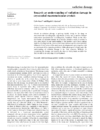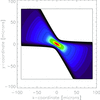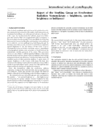issue contents
May 2005 issue

Cover illustration: Radiation damage at the macroscopic (visible damage to a protein crystal; Garman), microscopic (simulation of photoelectron tracks in a protein crystal; Nave & Hill, pages 299-303) and nanoscopic (loss of features in an electron density map; Ravelli, Nanao, Lovering, White and McSweeney, pages 276-284) levels.
facility information
radiation damage
Open  access
access
 access
accessThe current understanding of radiation damage in cryocooled macromolecular crystals is reviewed.
Open  access
access
 access
accessRadiation damage to insulin and thaumatin is limited to the irradiated volume. This has important implications for data collection strategies.
Open  access
access
 access
accessThe program RADDOSE is used to illustrate the important parameters governing the magnitude of the dose absorbed by X-ray irradiated protein crystals, with reference to a selenomethionine-containing example and a crystal of a highly X-ray sensitive native protein, for which calculations are compared with observed lifetime.
Open  access
access
 access
accessThe trade-off between redundancy and radiation damage for single-wavelength anomalous dispersion (SAD) experiments is discussed using an Se K-edge SAD data series collected on a third-generation synchrotron undulator MX beamline.
A practical application of two-wavelength MAD phasing in the presence of radiation damage is described.
Ionizing radiation creates free radicals in proteins. Sulfur groups are involved at the free-radical level but analysis of the final compounds indicated that the sulfur groups are not destroyed.
Calculations are presented for the reduction in absorbed dose when the path length of a photoelectron is greater than the size of the protein crystal. The reduced dose indicates that, in the absence of energy deposition owing to Compton scattering, higher-energy X-rays (20 keV or greater) could provide an advantage in reducing radiation damage for protein crystals of a few µm in size. A possible experimental set-up is described.
The influence of the incident photon energy on the radiation damage to crystals of a cadmium complex of porcine pancreatic elastase has been investigated.
Amorphous solvent in flash-cooled trypsin crystals transforms into an ultra-viscous liquid and drains from the solvent channels ataround 190 K, as seen by an abrupt decrease in unit-cell volume.
The problem of biocrystal heating by synchrotron X-ray beams is carefully analyzed using computational fluid dynamic modeling techniques which allow for the spatial variation in the local convection heat-transfer coefficient.
research papers
The Troika II beamline at ESRF provides versatile instrumentation for surface X-ray scattering methods from liquid and solid surfaces, interfaces, and thin films.
A generalized design of a prism-array lens for hard X-rays allows shorter focal lengths than previous geometries, while maintaining the feature size of the individual prisms. Experimental results for a lens made by deep reactive ion etching of silicon are presented. A focal line width of 1.4 µm was achieved at 13.4 keV.
A high-resolution multilayer monochromator with a bandwidth of 0.22% has been designed and installed on a bending-magnet beamline at CHESS to provide a monochromatic X-ray beam for protein crystallography experiments.
An alternative technique for measuring precise thermal expansion coefficients is presented and results for the linear thermal expansion coefficient for diamond between 10 and 300 K are presented.
A method of quantitative texture analysis is introduced that relies on direct examination of two-dimensional diffraction images with the Rietveld approach. It is illustrated with two biological examples, a dinosaur tendon and a salmon scale.
Properties, limitations and conditions of use are presented for the analytical ( ), `brute force' and Monte Carlo methods to determine error bars on fitted parameters in X-ray absorption spectroscopy.
), `brute force' and Monte Carlo methods to determine error bars on fitted parameters in X-ray absorption spectroscopy.
XAFS and computational simulation were used to study calixcrowns–caesium complexes in NPME (or OA). Useful information about caesium ion solution coordination chemistry was obtained.
computer programs
Beamline Scheduling Software is the schedule management and device control software for automatic operation of the SPring-8 RIKEN structural genomics beamlines. The details of the software design, current and future availability are described.
international union of crystallography
Open  access
access
 access
accesscurrent events
Free 



 journal menu
journal menu













































